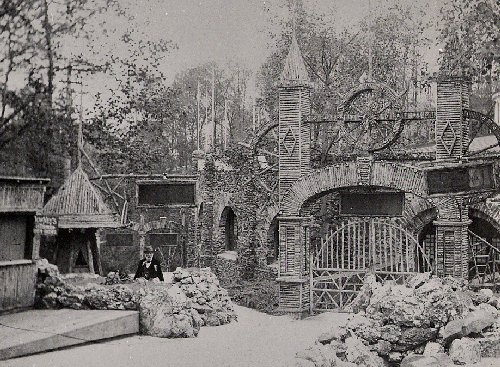
The Ampitheatre at Glen Echo Park
Glen Echo Amusement Park History
The Glen Echo Company was formed, in 1899, under the direction of Manager William Jeffers. Jeffers dubbed the old Glen Echo Chautauqua grounds "Glen Echo Park" and installed some new features. Within a year Jeffers' advertisements for Glen Echo proclaimed it as "A Resort for the Refined" and with such features as a carrousel, bowling, a pony track, shooting galleries, boating and a dance pavilion. Jeffers promoted Glen Echo as a family place with "plenty of amusements for the young and old. No objectionable characters. No spirituous liquors."
Fortunately abundant electricity was available since the Washington and Great Falls Railroad' trolley line extended from the city out to Glen Echo along the Potomac River. Trolley lines produced electric current far beyond their own requirements and Jeffers was quick to make use of this cheap source of power. In June of 1900, the amphitheater featured an animated slide show "The Battle of Manila." Although other amusement rides followed Jeffers could not make a success of his an amusement park at Glen Echo.
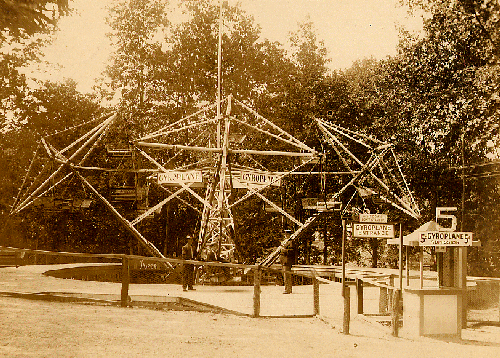
The Hydraulic Dive at Glen Echo
Glen Echo Amusement Park History
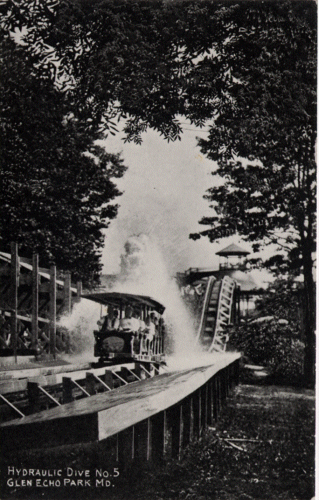
The Gyro Plane at Glen Echo
Glen Echo Amusement Park History
For the next eight years the park grounds were run by a series of managers. During this time Glen Echo Park had considerable competition. Marshall Hall Park, Washington Luna Park and Cabin John Bridge Park all vied for the patronage of Washington amusement seekers. To compete, Glen Echo added an assortment of electric rides. Two roller coasters were built. The Hydraulic Dive for the less adventurous riders and The Dip for the more daring. In 1904 a new larger carrousel was installed, as well as an innovative ride called the Gyroplane. But even with these additional amusements stiff competition kept Glen Echo from becoming Washington's major amusement park.
In 1906 Alonzo Shaw, the new manager of the park, wanted to convert Clara Barton's house into a hotel. After he failed to get Miss Barton's approval Shaw discovered a discrepancy in the original deed and tried to force Miss Barton out. This plan also failing, Shaw next tried to drive Clara Barton out by harassment. He constructed a "scenic railway" which looked much like a roller coaster, but which was mainly level and slow moving enough for the riders to enjoy the scenery. Clara Barton recorded the construction of the railway in her diary.
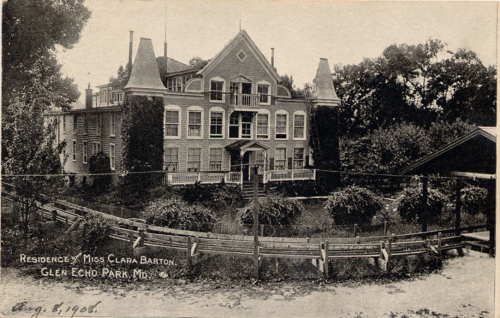
Scenic Railway tracks at Clara's front door
Glen Echo Amusement Park History
"The new railroad of Mr. Shaw is going up in front of our front door. It is evidently the intention to build up all around us until we are a mere box and will be glad to leave. I see no reason why he cannot build up within a few feet of the house on all sides and I think he will."
He did just as Miss Barton surmised, half circling her house and installing a station directly before the front door. Next he erected a Ferris wheel in front of the house, but also without the desired result. So Shaw extended the back turn of The Dip so that it turned by Miss Barton's second story window. That same summer Miss Barton recorded the following in her diary.
"... The evenings are very pretty-the lights (of the Glen Echo Amusement Park) cheerful. The noise in no way Disturbs us."
Miss Barton had time on her side; the amusement park was not the success that Shaw had expected. As a last attempt to save the failing park Shaw expanded the park's features adding "a railway ride through a waterfall" and a large picnic area. Moving pictures had been a feature for a year, and were held in the amphitheater (now called the "hippodrome"). But none of these new features were adequate to reverse Glen Echo's decline and by 1908 Shaw came to Clara Barton to borrow money to finance the park. Miss Barton did not loan him the money and when the season ended, so did Alonzo Shaw's dreams for Glen Echo.
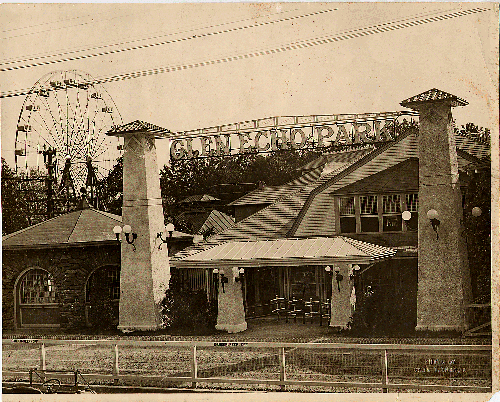
The Entrance at Glen Echo
Glen Echo Amusement Park History
Reliable information is sketchy for the 1909 and 1910 seasons but it appears that by early in 1909 the Washington Railway and Electric Company managed the park, continuing to operate the rides. They discontinued vaudeville, offering summer opera instead. But did little to improve the park.
Washington Railway and Electric's management felt the park had promise and in March of 1911, received clear title to the land and all of it's improvements, establishing a new Glen Echo Park Company and immediately hired Leonard B. Schloss as vice president and general manager. Schloss, then thirty-eight years old, was a twenty-year veteran of the amusement and entertainment field. He had worked in the theater, vaudeville, for fight promotions, a World's Fair as well as five years with the Ingersoll Luna Parks. Ingersoll was impressed enough with Schloss to make him manager of three Ingersoll parks including Washington Luna Park one of Glen Echo's direct competitors.
Schloss set out immediately to rebuild and improve Glen Echo. His first action was to announce to the public that there would soon be "No finer Amusement Park anywhere". Schloss also announced that he would add at least one major ride or attraction each year.
Schloss mounted a major promotional plan, using all his savvy and experience to make Glen Echo the foremost Washington amusement park. Advertisements written in article form appeared in Washington's newspapers. The Washington Herald printed the following on May 21st 1911.

The Ferris Wheel at Glen Echo
Glen Echo Amusement Park History
"...No department has been overlooked in the general renovation of Glen Echo Park.... The spacious interior of the amphitheater has been entirely remodeled into a 'New Midway,' fashioned after Coney Island's Steeplechase Park.... Other attractions include a novel marine toboggan.... Miniature railway, Ferris wheel and a new boating pavilion on the banks of the canal.... And the usual quota of standard attractions provided in resorts that cater to ladies and children."
As an additional incentive the admission to the park was eliminated. For the first time entrance to Glen Echo was free. Schloss encouraged fraternal organizations and Sunday School classes to hold their annual outings at the park, with special group rates available. To improve public image, Schloss instituted Orphan's Day, opening the park to the residents of the city orphanages. Orphan's Day remained a tradition of the park for over twenty-five years. Not a trick was missed, the park had "Special Days" for almost every imaginable occasion and person, including Redhead Night, Blonde Night and Waltz Contest Night.
Not everything ran smoothly; Glen Echo experienced a drought in 1911, and the Mayor of the Town of Glen Echo, (incorporated seven years prior) asked Schloss to close the park on Sundays to conserve water. When Schloss declined, Mayor Witkowski took matters into his own hands, writing out warrants for the arrest of the park management. The town Deputy Marshal Walter Shaw, who was also owner of the Ferris wheel at the park, refused to serve the warrants, noting that processing of warrants on Sunday was a violation of Maryland's Blue Laws. Witkowski responded by cutting off the water supply to the park, which also supplied the town, and when confronted by three Town Councilmen (also employees of the park) refused to turn the water back on. The conflict escalated to the point where threats and a gun were involved. But the councilmen overpowered the Mayor and the water was turned on. However the following morning, Witkowski retaliated. A county judge and officers appeared at the park and arrested 111 employees including 96 town residents. In the end the park closed it's rides on Sundays. The Town Council and the Mayor never resolved their differences and Witkowski finally resigned and moved to Kensington.
The publicity, generated by the conflict, increased attendance, Glen Echo was finally a success! By the end of the season the local newspapers were extolling the praises of Schloss. The Washington Herald printed the following:
"The financial success obtained this summer through operating the park under a liberal management policy under the direction of L. B. Schloss, proves that Washington will support a metropolitan outdoor amusement park if conducted along lines of respectability."
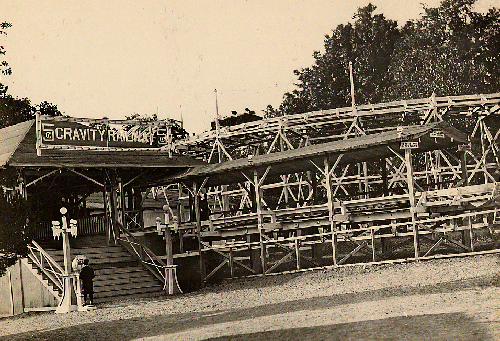
The Gravity Railway
Glen Echo Amusement Park History
Each year Schloss exceeded his promised "at least one" new attraction. Attendance grew as the number of rides increased. Over the next few years a new carrousel organ was installed, a new roller coaster, The Gravity Railway, was purchased from the Philadelphia Toboggan Company, and new features were added to the midway, along with other improvements to the grounds. All the paths in the park were repaved and the Ferris wheel was moved from Clara Barton's front yard to the park proper.
By 1916 the park grounds were full. The Gyroplane was removed to allow construction of the Derby Racer, a roller coaster with two cars running on parallel tracks. The pattern for the future was set as older rides and buildings were removed to make way for new.
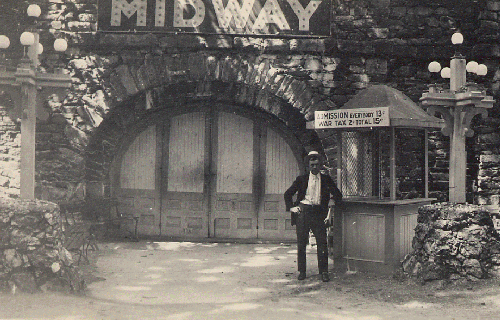
War Tax
Glen Echo Amusement Park History
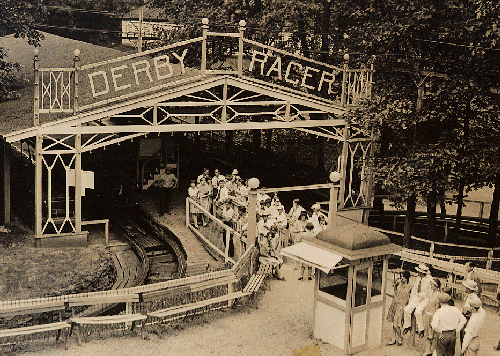
The Derby Racer
Glen Echo Amusement Park History
The First World War had little effect on Glen Echo, although a two-cent war tax was imposed on most of the amusements. New rides were added in spite of the difficulties of transporting them to the park, because the country's railroads were needed for war transport. In 1918 The Whip came to Glen Echo, which was one of the first fast "scary" rides installed other than the roller coaster. The Whip remained at Glen Echo for the rest of its life as an amusement park.
In 1918 the first fatality at the amusement park occurred when Joseph J. Hamel, a 43 year old stone cutter from Washington, fell from a Gravity Railway car while sitting on top of the back of one of the seats. Hamel was rushed to Georgetown Hospital but died the next day. Unfortunately roller coaster deaths became a regular event at the park, though malfunction or design was never the cause. In every case the rider was not following the posted safety rules.
In 1920 the first "Tunnel of Love" was built. The ride, called The Olde Mill, became a favorite at the park, and featured views of life in the country as well as pristine mountain scenes along the dark walls covering the water trough. Boats with six seats cruised slowly through the tunnel though rarely with more than two to a boat! Many couples who attended the park during the twenties and thirties fondly remember the Olde Mill.
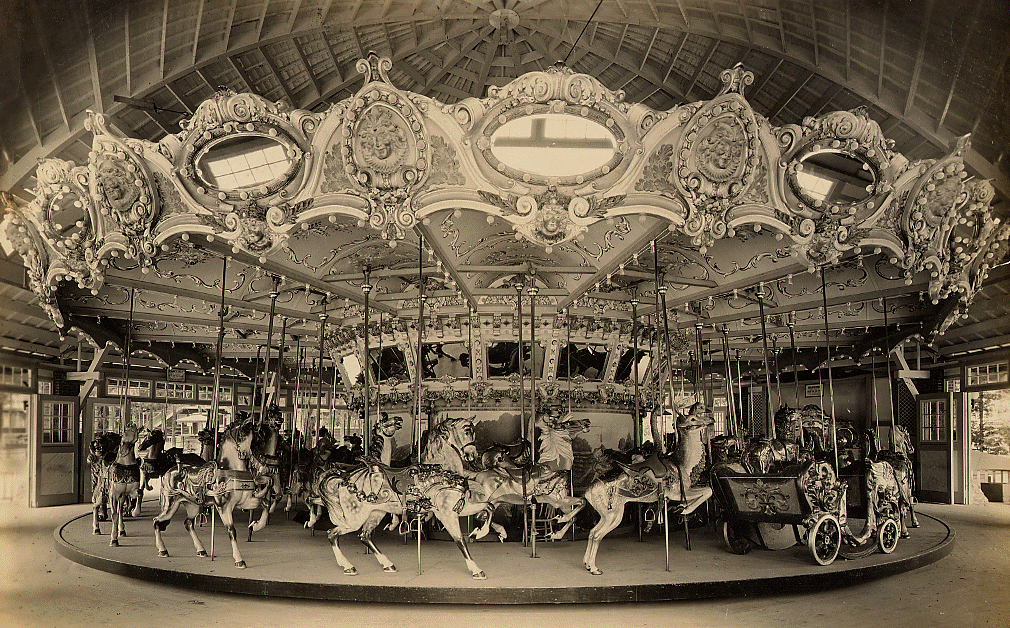
The Glen Echo Carrousel
Glen Echo Amusement Park History
1921 was the year the old Wm. F. Mangles Co. carrousel was replaced with a brand new carrousel made by the Dentzel Co. of Philadelphia. The new carrousel featured other animals besides horses, such as giraffes, rabbits, ostriches, a lion, a deer and two chariots for the more sedate riders. Also added that year was a new roller coaster, The Coaster Dips, which was to remain a favorite at the park for the next 48 years. The original ride featured seven dips plus numerous curves and turns.
Attendance at the park continued to climb, although during the 1920's Schloss cut back on spending; his promise of one new annual attraction was usually a revamping of old buildings or rides. Guide books referred to Glen Echo as a family place, annual Sunday School outings HAD to be at Glen Echo, where else, for Glen Echo had become Washington's premier amusement park just as Schloss had planned.
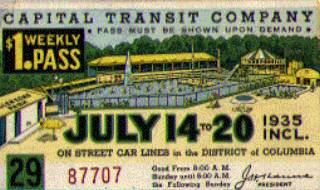
The years of the Great Depression were years of prosperity for Glen Echo and the worse the economy grew the more people flocked to the park in an attempt to escape day to day cares. On a typical weekend 30,000 people would visit the park, and this increase in business allowed Glen Echo to build significant new attractions. In 1931 the Crystal Pool was built, big enough for 3000 swimmers and featuring a real "Sand Beach". The Art Deco style of the pool, popular in the 30's became Glen Echo's new look. Older rides were given Art Deco facades, including the bumper car building, which was been installed in 1923. In 1933, the Spanish Ballroom was built, and its 7,500 square foot dance floor was a hit from the beginning. Park visitors would end a long day at the park with an evening of dancing, while others came specifically to dance. Many popular bands played at Glen Echo's Ballroom, Lawrence Welk, Tommy Dorsey and others leading bands played to capacity crowds of 1,800 dancers. Big Band music ruled the ballroom for the next twenty years.
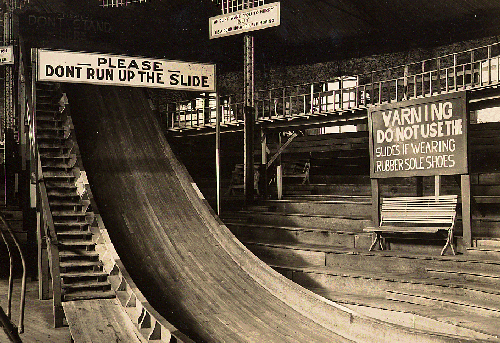
The great wooden slide
Glen Echo Amusement Park History
In the middle of the decade Schloss revamped the midway, filling the old amphitheater with new attractions including a 90-foot long wooden slide. The maple slide was highly polished and to prevent friction burns, sliders sat on burlap sacks. While the sacks certainly helped, those who recall the slide also recall frequent burned knees and elbows. When older rides were rebuilt in a modern style, they made quite a contrast to the rustic amphitheater shell, and the old Chautauqua benches still remaining in the midway.

The new office building
Glen Echo Amusement Park History
Glen Echo finished the 1930's profitable, and after the close of the 1939 season Schloss began the largest construction project in Glen Echo Park since the 1891 Chautauqua season. During the winter the old Chautauqua Hotel and Administration Building was demolished, and the Amusement Arcade, housing a shooting gallery, skeeball area, barbeque pit and other attractions, was also torn down. To replace them an extensive complex of buildings was constructed to house all of the previous features, and provide room for growth. Instead of just a barbeque stand, Glen Echo would offer three restaurants along with the fast food booths. In keeping with previous construction, the style was distinctly Deco.
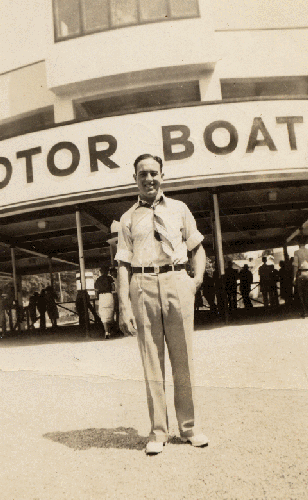
The Motor Boats
Glen Echo Amusement Park History
Keeping Glen Echo popular meant keeping the public entertained, and the 1940's were years of innovation at the park. The installation of a motorized boat ride gave the park a head start on the new decade. People were no longer content with the simple diversions of years past; park patrons wanted faster and more exciting rides, rides they could control to some extent; the motor boats fit this need. Glen Echo's boats were real; gasoline powered motor boats floating in a winding trough of water, were under the control of the rider, though with a limited top speed. To prevent accidents the waterway was too narrow to permit the boats to turn around.
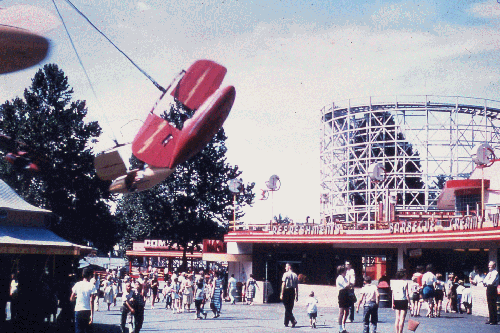
The Flying Skooter
Glen Echo Amusement Park History
The Flying Skooter, also installed in 1940, was another rider-controlled device. The flying skooter replaced the old Aeroplane Swing's two seater bi-planes with sleek stylized air cars. The rider could control the height of the car by manipulating a hinged rudder in front of the seat. By careful angling of the rudder it was possible to make the car point headfirst towards the ground instead of in the direction of travel. Glen Echo's Flying Skooter was only the fourth such ride in the world and the first in an American amusement park.
Suddenly though, rumors again threatened Glen Echo. The rumors spread throughout the Washington area. A young girl had been bitten by a poisonous snake while riding in the "tunnel of love", snakes were rampant in the Crystal Pool, the Roller Coaster had jumped its tracks killing nearly a dozen people and that the park, due to these tragedies, had closed its gates. Despite an extensive advertising campaign the rumors persisted, and attendance at the park dropped for a short period until the Montgomery County Police assigned a detective to help quiet the false rumors, attendance slowly returned to normal.
NOTE: The "poisonous snake in the tunnel of love" rumor has plagued amusement parks throughout the country since the mid-1930's; the rumor surfaces periodically to harass some undeserving park.
By 1941 the world's attention was on the war in Europe. Workers swarmed to Washington to fill the many new jobs created by America's expanding military and men in uniform were given special discount rates at Glen Echo. Gas rationing the following year benefited Glen Echo. Special rates for round trip trolley rides to the Park tempted crowds trapped in the area by rationing. Glen Echo "did its part" and installed special lighting with decreased visibility from the air; enabling the park to be completely blacked out in less than three minutes.
However gas rationing closed the Motor Boats from the start of the 1943 season, and wartime shortages were felt elsewhere at the park. Ammunition, needed for the war effort, closed the shooting gallery. There were shortages of popcorn, soda pop, peanuts and hot dogs. Guards at the grounds were hard to keep, as they enlisted with the armed forces.
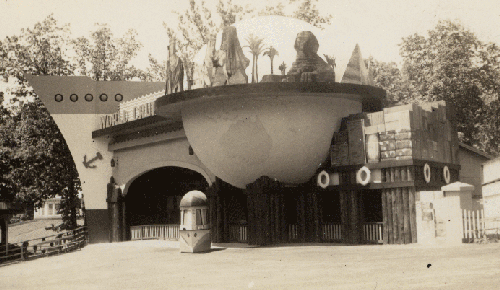
The World Cruise
Glen Echo Amusement Park History
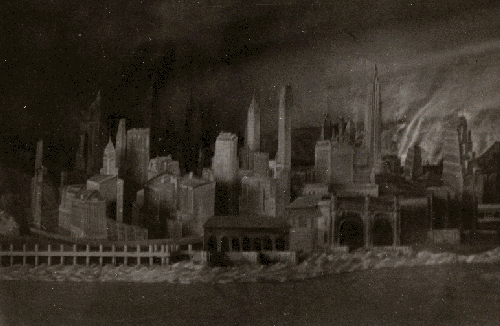
The World Cruise, interior scene
Glen Echo Amusement Park History
The park's management responded to the changes brought by the war, the Olde Mill was converted to the World Cruise, it's pastoral scenes replaced with scenes of Europe. The Beanbag Toss booth was replaced; now people threw a baseball at Hitler's face through a toilet seat's ring.
In 1949 Glen Echo lost one of its main attractions when the Midway (the old Chautauqua amphitheater) was condemned by the Fire Marshal and closed its doors. To offset the loss, Leonard Schloss and the park management installed Kiddieland, a collection of classic amusement park rides for the under-twelve set. Also that year, at the end of the summer, Leonard Schloss retired after thirty-nine years at the park.

The Comet Jr
Glen Echo Amusement Park History
Gerald Price, the new manager, opened the 1950 season with attractions, which illustrated the future direction and focus of the park. The World Cruise was demolished to make way for a children's roller coaster, the Comet Jr., and for the next three years children's attractions were highlighted. Kiddieland was expanded and roofed over to provide shade and allow operation during rain. Children's television personalities drew huge crowds. The Howdy Doody Show, one of the most popular, made regular appearances over the following years.
Not all of the park's attractions were intended for children. The Spanish Ballroom still featured Big Bands along with a new feature, beauty contests. The Miss Glen Echo contest became a yearly feature. Other beauty contests held at the park included Miss Washington Press Photographer and the Washington area Mrs. America contest. Drawings to give away new cars became a regular feature at Glen Echo.
Glen Echo's future seemed bright By 1953 attendance levels were so high it was necessary to centralize ticket sales. Previously each attraction had its own ticket booth, which slowed entry to the rides. Tickets were now sold separately or in blocks of ten at 15 cents each. There was still no minimum purchase or admission fee to enter the park.
In 1955, in California, something new threatened the small town amusement park. Walt Disney, riding on the success of his cartoon characters, opened Disneyland, offering a quantity and quality of attractions unmatched anywhere. Over the next ten years theme parks across the country replaced the small town parks. Glen Echo held out longer than most, but in time the park's property value exceeded its profits.
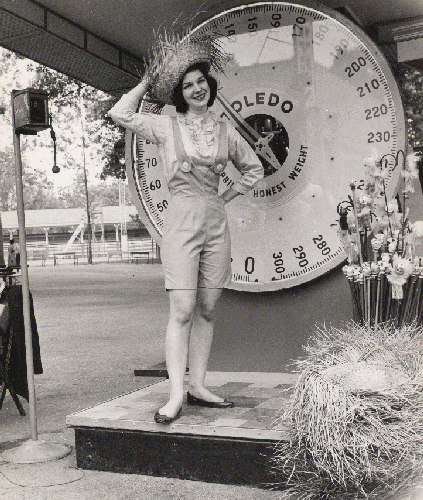
The scales
Glen Echo Amusement Park History
In spite of the popularity of Glen Echo, and a record breaking opening day attendance of 25,000, Glen Echo Park was sold on June 17th, 1955. The Washington business community was not surprised. The previous year The Capital Transit Company (successor to Washington Railway and Electric) had been broken up by court order in a monopoly suit. An amusement park was not in keeping with the central purpose of Capital Transit therefore Glen Echo was sold to the Rekab Company for just under one million dollars.
The park under Rekab's management was troubled from the start. Less than two weeks after the sale a transit strike stopped trolley traffic to the park, reducing patronage by twenty percent. On top of this, plans to remodel the amphitheater into a roller skating rink fell through when construction estimates exceeded $300,000 and Rekab destroyed the building by fire under the supervision of three local fire departments. The amphitheater "built to outlast the ages" met its demise on September 16th 1956. Initial plans to restore the creek valley were scrapped, in favor of the addition of more parking space.
From its inception Glen Echo had been open only to a white clientele; the management was determined to maintain this segregated policy. In 1957 Glen Echo Park was requested informally to abandon segregation. This failing, Howard University students and concerned community residents began picketing the park in earnest in 1960. The park management refused to negotiate, by the end of the season segregation remained. However the combination of public opinion, community efforts, pickets, law suits and the threat of court ordered desegregation was successful; in 1961 Glen Echo opened it's gates to all races. The installation of a ticket booth and the institution of an "admission charge" in the form of a minimum ticket purchase accompanied the change in policy.
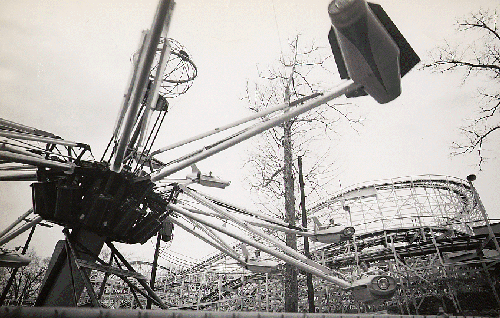
The Satellite Jet
Glen Echo Amusement Park History
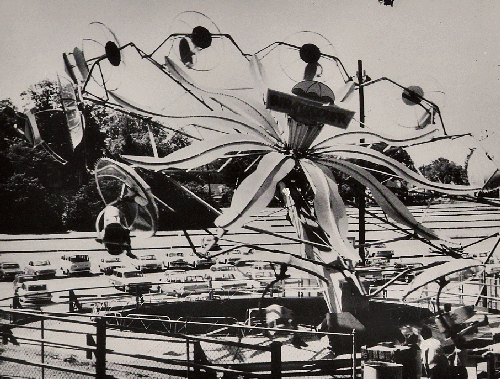
The Paratrooper
Glen Echo Amusement Park History
Few new features were added between 1958 and Glen Echo's closing at the end of the 1968 season. The biggest additions were the Satellite Jet in 1959, the Paratrooper in 1963, Jungleland in 1964 and the Alpine Hi-Ride in 1966. But Glen Echo lost an old friend; the trolley line from Washington to the park was closed before the start of the 1961 season.
Desegregation did not alleviate racial tensions at Glen Echo. On Easter Monday, 1966 the roller coaster was closed early in the day due to damage to the tracks from a cigarette thrown from a coaster car. Unhappy black youths from Washington became disruptive when the roller coaster was "closed without explanation" and as tension escalated, the park was closed for the day. Reports of slashed seats on the first returning bus to the city prompted D.C. Transit, to cease bus service to Glen Echo, stranding hundreds of people at the park. The long walk back to the city was accompanied by minor vandalism, adding to tensions in the communities surrounding the park.
After the 1966 disruption, attendance at the park fell. Citizens groups petitioned the County Council to close the park permanently or at the very least limit the number of park patrons to a "manageable number." The petitions were made pointless by declining attendance. Former patrons afraid of recurrences avoided the park. Glen Echo Park developed a reputation of being a haven for teenage gangs. Well founded or not, rumors added to the problem of declining business and Glen Echo Park closed its gates for the last time at the end of the 1968 season.
Rekab, the owners of the park foreseeing the eventual closing of the park, were seeking buyers by 1964; there were rumors of a price of one million dollars being asked. The next year Rekab proposed erecting four sixteen-story apartment/hotel buildings on the park site. The Potomac Valley League, a citizen's group, appealed to the Montgomery County Circuit Court and the Federal Government to prevent further development on the Glen Echo Park site.
Rekab tried again to sell the property but the deal fell through when the potential buyer was informed that the National Park Service would not permit access for construction vehicles over the George Washington Parkway. Likewise, the Army Corp of Engineers stated that it would not allow access over MacArthur Boulevard effectively blocking all access to the property. After that; the Court reversed its previous decision in favor of Rekab and prohibited construction of apartment/hotels within one half mile of the Potomac River throughout the County with scenic easement being cited as the reason.
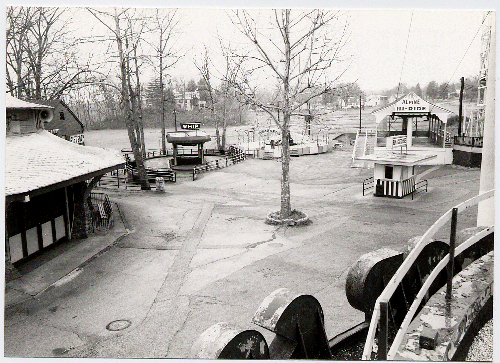
Closed Park
Glen Echo Amusement Park History
The Baker brothers, owners of Rekab (Baker backwards) approached Maryland Senator Daniel Brewster to help them out of their predicament. Since the government had prevented them from developing their own land, perhaps the government would buy the land from them. Preliminary meetings took place but the National Park Service rejected the price of $2,000,000. After further negotiations the Bakers agreed in principle to a land swap in which they would trade the Glen Echo Property for surplus government land of equal value which would not have the development restrictions of the Glen Echo property.
Local resident's concerns were expressed in the various proposals written recommending uses for the property. Most of the proposals suggested a mixture of residential, light commercial and parkland. The Glen Echo Town Council published the most comprehensive plan. In 1967 Senator Brewster suggested establishing Glen Echo as an Historic Landmark. His plan proposed retaining the carrousel, swimming pool and Ferris wheel and rebuilding the amphitheater, under the administration of the County, as a County Park.
In 1968 the Department of the Interior and the National Capital Park and Planning Commission requested the General Services Administration to attempt the acquisition of the Glen Echo Property by means of a swap. The conditions of this swap were to include the land and all permanent structures. With the acquisition in process, the Bakers announced in April 1969 that the park would not open that year. In 1969 and 1970 the Bakers sold off most of the rides and amusement devices.
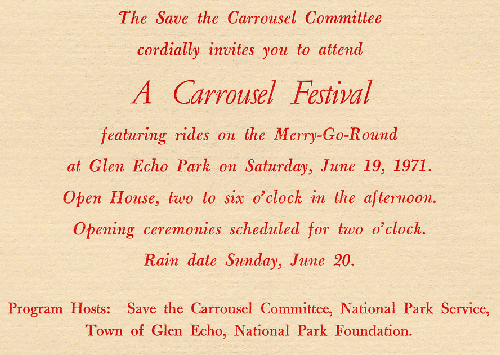
Save The Carrousel
Glen Echo Amusement Park History
The majority of the rides were sold off quietly to other amusement parks and private collectors, but one sale made the public take notice. In April 1969, the 1921 Dentzel carrousel was sold to Jim Wells, of Falls Church, Virginia. Local citizens who wished to keep the carrousel at Glen Echo formed the Save the Carrousel Committee, and began raising funds to buy the carrousel back from Wells. The group, headed by members of the Glen Echo Town Council, entered into negotiations with Wells, but in April of the following year Wells sold the carrousel to California collector Mike Roberts. Roberts planned to move the carrousel to California. The Save the Carrousel Committee dealt with Roberts, (with Wells acting as the intermediary). A price of $80,000 was set with a deadline of May 1st. The Committee raised the funds within the one month period through individual contributions and with substantial help from local organizations and philanthropists.
The $80,000 was presented as a gift to the National Park Foundation who purchased the carrousel from Roberts. The Foundation in turn transferred it to the National Park Service. The gift was made on the condition that the carrousel remains at Glen Echo and remains open to the public.
On April 1st, 1970, the General Services Administration formally acquired the title to Glen Echo Park. Shortly thereafter the National Park Service took over administration of the park, and with high rise development stopped and the scenic environment of the Potomac Valley preserved, what to do with Glen Echo became the next question.
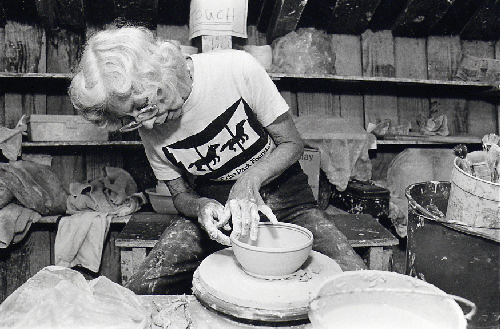
Arts
Glen Echo Amusement Park History
In June of 1971 Glen Echo Park was reopened to the public. A series of Sunday afternoon events was offered stressing the performing arts. Classical music and outdoor ballet were among the entertainments offered.
The following spring site manager Bill Anderson and and arts specialist Wendy Ross conducted three days of public meetings. The plans which resulted called for Glen Echo to be a participatory arts park, a "People Park," reviving the Chautauqua concept of broad based education in the liberal arts for the public. From Edwin Baltzley's writings a theme arose.
"To promote liberal and practical education, especially among the masses of people; to teach the sciences, arts, languages, and literature; to prepare its patrons for their several pursuits and professions in life, and to fit them for the duties which devolve upon them as members of society..."
The amusement arcade became a home for Adventure Theater, an adult run theater for children. The ballroom was used for dance classes. The old cafe kitchen housed the Graphics Workshop. Other structures were converted into areas for classes, workshops and performances. More room was needed, so six Yurts (reproductions of Mongolian sod roofed huts) were found in storage from a canceled Washington festival and erected on the site of the demolished roller coaster to provide studio space for artists.
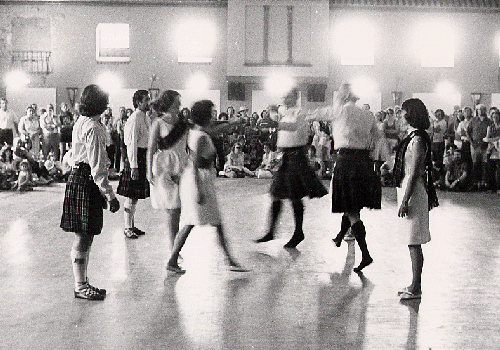
Dances
Glen Echo Amusement Park History
Classes and workshops were offered in a wide variety of arts and crafts including painting, ceramics, dancing, graphics, textiles, acting and sculpting. In 1972 the Children's Experimental Workshop opened under the direction of Wendy Ross offering education in the arts and crafts to handicapped and disadvantaged children.
By 1974 the arts program had grown to include an Artists in Residence program, with artists receiving studio space in exchange for teaching classes and participating in several festivals each year. The artists sold their work in a gallery constructed in the porch areas of the ballroom. Another new feature was the "Chautauqua School", providing a full academic curriculum, with intensive arts training, for twenty Montgomery County students. The students built their own classrooms in the amusement park's cafe.
In spite of all this successful activity by the National Park Service, The Office of Management and Budget tried to "shed" Glen Echo off onto either Montgomery County or the state of Maryland in 1975. This action, seemed inconsistent with the Park Service's acquisition of the Clara Barton House, and the recent restoration of the Chautauqua Tower roof, and aroused citizen's groups and concerned state officials stepped in to stop the OMB action. On March 5th, 1976 Glen Echo was formally transferred to the National Park Service.
From the mid seventies until 1982, the Park Service enlarged its programs and the list of available classes grew. A typical schedule of classes offered ceramics, enameling, spinning, weaving, photography, drawing, painting, mixed media, fabric decorating, leather working, framing, sculpture, silk screening, drama, dance, music, yoga natural foods and ecology. The Art Gallery moved from the Ballroom to the newly remodeled Tower and began year-round operation. The third floor of the Tower was opened in 1977 as a museum displaying artifacts and photographs from Glen Echo's past. After one season the fire marshal closed the second and third floors of the Tower due to inadequate fire escape routes.
New activities added in 1977 included a series of weekend dances held in the Ballroom with dance styles to please every taste. Square dances one week were followed by Israeli folk dancing the next. Many other forms of folk and period dancing were offered, including traditional ballroom dances. The Folklore Society of Greater Washington began holding its annual Folk Festival at the park. To keep the Park's offerings fresh, a plan was devised to use the yurts for "Chautauqua Summer Artists." The summer artists were temporary residents who had use of a yurt for a single season, the plan was implemented the following Summer.
Glen Echo's new success lasted until Federal budget cuts in 1981. These hit Glen Echo hard; lack of funds stopped the regular weekend dances, and plans to restore or stabilize deteriorating buildings were halted. Within a year many of the buildings used for artists studios were condemned or destroyed. The unused 'Laff in the Dark' building was demolished, along with the Crystal Pool (the Pool structures housed the sculpture foundry). Portions of the buildings housing the Writers Center (a workshop for authors, poets and graphic artists) and the photographic studios were condemned and the artists displaced. Not everything ground to a halt. Some stabilization and restoration funds had been allocated before the cuts and rehabilitation work was performed on the Ballroom. Dances were restarted with a restricted schedule and in 1983 Glen Echo first hosted the Washington Folk Festival which had been held elsewhere the previous six years. In spite of the cutbacks Glen Echo was awarded the Maryland Park and Recreation Association's 1983 Arts Forum Award.
Budget cutbacks caused funding for major renovations to again be cut in 1985. The following spring word leaked out that the National Park Service planned to put out a request for proposal to lease Glen Echo Park under the Congressional Historic Leasing Act of 1966. Historic Leasing would have permitted limited commercial development of the park while preserving the exteriors of the historic structures. This seemed to the Park Service to be a reasonable alternative method to preserve the rapidly deteriorating park's buildings.
As in the past, public reaction to the planned request for proposal was swift. Two Glen Echo enthusiasts potter Kathy Darby and woodworking student, Tory Cowles, called a meeting to address concerns about the park's future. Nineteen people, including park artists and community residents, attended. By the end of the meeting the Save the Glen Echo Park Committee had been formed, headed by volunteer Chairman Dr. Phil Speser.
The Committee's first action was to call a public meeting at the Glen Echo Town Hall on May 14th, 1986. Public reaction was overwhelming and attendees overflowed the Town Hall. From this meeting came two action groups, a short term committee was to attempt to postpone, or cancel, the planned request for proposal, while a long term committee was given the task of designing a viable alternate to Historic Leasing.
The long term committee's alternative was to form a non-profit foundation whose mission would be guaranteeing preserving Glen Echo Park and its contemporary cultural, educational and recreational programs. Within one year the committee had established bylaws, incorporated, and composed the document upon which a Memorandum of Agreement with the National Park Service was based. In May of 1987, a signing ceremony was held complete with speeches and a cake to mark the formal beginning of the Glen Echo Park Foundation.
Within two years the Foundation, under the direction of its second Chairperson, Carol Trawick, had won the recognition of the State of Maryland and was awarded a $300,000 matching bond for restoration of the Spanish Ballroom. Montgomery County also awarded $30,000 toward a fire suppression system for the Dentzel Carrousel, which was promptly matched by the Mercedes Benz Dealers of Washington. The Foundation is still active in its efforts to raise funds for the preservation and continuance of Glen Echo Park.
The future of Glen Echo is still uncertain. National Park Service preservation efforts continue, as shown by the recent restoration of portions of the Dentzel Carrousel, but funds are limited. The Glen Echo Park Foundation is still active in its efforts to raise funds, yet ultimately the future of Glen Echo is once more in the hands of the public.
Addendum
Much has transpired at Glen Echo since this history was written in 1997; the carrousel has been completely restored, the main office building has been replaced, the "yellow barn" has been demolished and rebuilt, and the list goes on. When time permits, recent changes will be added to this history.
Richard Cook
December, 2008
Note
Now in its second printing, Glen Echo Park: a story of survival presents a more comprehensive history of Glen Echo, including nearly 100 high quality photographs of the Chautauqua and Amusement Park through the years.
The book is available HERE
|




